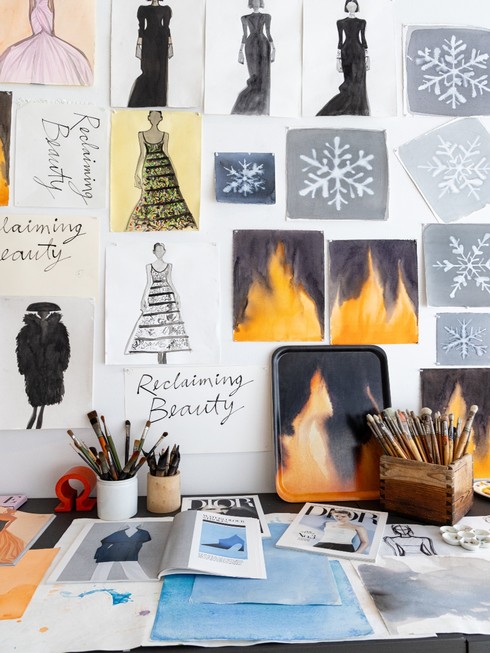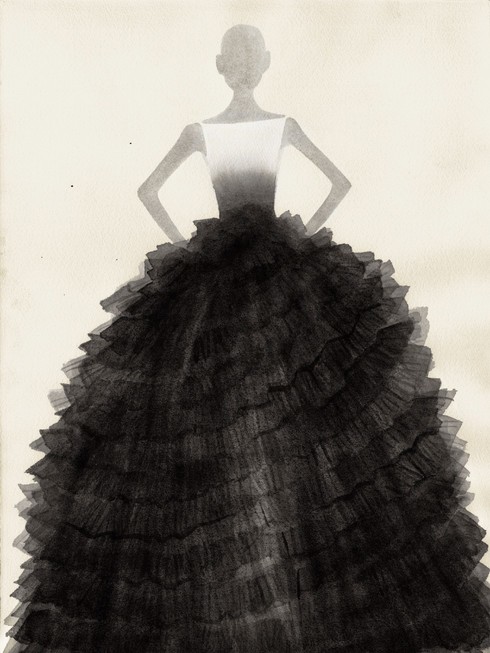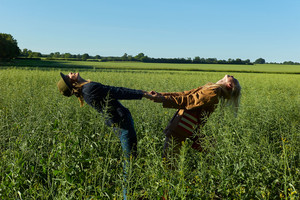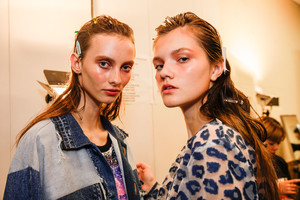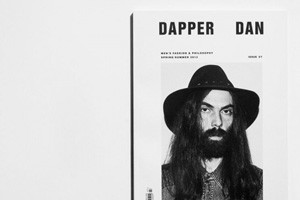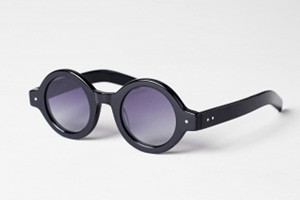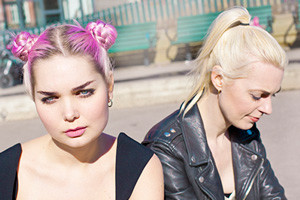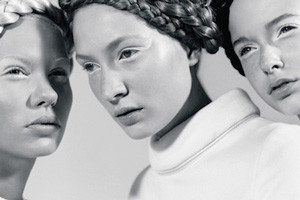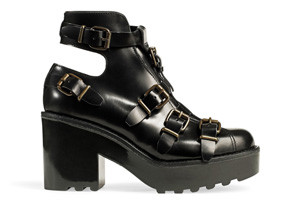Mats Gustafson and Ted Muehling's journeys in Reclaiming Beauty
Written by Natalia Muntean by Ulrika Lindqvist“He was wilder than me,” jokes jewellery designer Ted Muehling about his partner referring to Mats Gustafson's spirited early years in New York. “The city was kind of a magnet at that time. People came from everywhere,” continues Swedish illustrator Mats Gustafson about New York in the 70s, when he crossed the Atlantic in search of parties, creative freedom and himself. In the realm of both artistry and love, the influence between two individuals can be a profound and transformative force. In talking with Mats Gustafson and Ted Muehling about their beginnings as artists, their sources of inspiration, and the “Reclaiming Beauty” exhibition, I observed glimpses of this force, along with a strong sense of complicity, respect for each other's work, tenderness and humour. The couple, who have been together since the 90s, are currently showcasing their works in a joint exhibition hosted by Millesgarden, one of Stockholm’s most famous museums.
Mats Gustafson’s artistic journey began in the late 1970s. While studying set design at Dramatiska Institut, he started doing fashion illustrations on the side. It was H&M that was one of his first collaborations and he considers it to be his proper school. “We’re talking about the late 70s. They were still doing advertising with illustrations and that’s how I learnt to work fast,” he recalls. Since then, he has worked with renowned fashion brands, such as Chanel, Comme des Garcons, Yohji Yamamoto, Svenskt Tenn, Viktor & Rolf and many more. His dedication to creating with his hands and paper has set him apart as an artisan. For the past ten years, Gustafson has collaborated with Dior, creating illustrations for some of the most iconic looks of the French fashion house. “My job is to understand and depict the designer’s work. I want to find the best in it, or what I consider the best, and interpret it,” he says about his work in this world.
Mats reflects on his transition into exhibiting commercial art, a departure from his usual applied art. This shift presented both a challenge and an opportunity to view his work through a different lens. “Working with applied art or commercial art works very well for me,” says Mats. “I like not having to make up my mind all the time; somebody else decides, and I appreciate that. But I think, at some point, when I had my first show, exhibiting commercial art was an unfamiliar experience. It required me to look at it differently. Is it worth looking at? It’s meant to be consumed, and especially in the fashion world, you know how fast things move.” He recognizes that every exhibition brings something new and unfamiliar. Despite his illustrious career, he confesses, “I’m still learning. I’m still inexperienced.”
The AIDS epidemic represented another major turning point for his art. It influenced his desire to create more portraits and explore themes of intimacy, homosexuality, and death as a way to deal with the crisis. Amidst his enjoyment of fashion-related work, he recognised the need to delve deeper and convey more profound themes. It was during this period that he gravitated towards nudes as a means of artistic expression. “My first work out of fashion was to do nudes,” he reveals. Stripping away the clothes allowed him to embark on a new artistic path. Nudes, for him, represented the most fundamental subject to depict, opening the door to exploring other classical themes such as nature and interiors and this shift marked a transformative period in his creative evolution.
Always having nature as a starting point, Ted Muehling has created jewellery and objects inspired by nature since 1976. With a major in industrial design, he was drawn to the poetic and artistic side of making functional objects. While many of his classmates were venturing into car and appliance design, Muehling had a different vision. “I preferred creating beautiful shapes that you can hold and touch,” he shared. Despite not taking a specific jewellery class, Muehling’s talent caught the attention of the head of his department, who allowed him to focus on live drawing instead of automotive designs. “He was very generous in giving me the freedom to choose interesting subjects,” Muehling reflected. He embraced a hands-on approach, working directly with the materials to truly understand their potential. “I always think architects should build a house before using a computer, just like they build a structure,” Muehling mused, highlighting the importance of hands-on exploration. He found great joy in experimenting with materials, especially in the realm of jewellery, and acknowledged the serendipitous moments that arise from such exploration. “You see what it does, and then you think, ‘Oh, that’s a good direction.’ It keeps feeding you surprising elements,” he added. The first piece he created is part of the Reclaiming Beauty exhibition and was inspired by Gingko trees found in New York. Their bright yellow leaves adorned the streets during autumn, forming captivating shapes. “I tried to interpret this shape, which could resemble a fishtail, using a long stone and created a pin hair,” he shared. Since then, Muehling has cultivated a niche following that appreciates the authenticity and simplicity his designs embody. “We represent a quieter, more authentic life,” he asserts. He describes his customers as smart women who avoid status trappings and materialism. Their search is for something deeper, a connection to their essence. Muehling's creative journey is not just about aesthetics; it's about balance and harmony. “The jewellery I create should be a subtle punctuation mark, an intriguing little movement, as a dear friend of mine describes it. It shouldn't overpower or overwhelm. Finding the balance between too much and too little can be challenging, but it's essential,” he tells me.
Muehling's path to success has been a gradual one, spanning nearly five decades. From having a few assistants to a team of 11 dedicated individuals, he has crafted a business that supports and nurtures its members. “I feel lucky to do what I love with such wonderful people,” he says.
Mats Gustafson and Ted Muehling’s connection transcends beyond creative collaboration. The pair met in New York after Gustafson moved there in the 70s in search of parties, creative freedom and himself.
The fascination with nature has remained a pillar of Muehling’s artistic journey and has become a significant part of the pair’s relationship. Nestled in the picturesque landscape of Eastern Long Island, Mats’ country house serves as a sanctuary where their creativity and creative spirits intertwine. Gustafson’s artistic vision is profoundly affected by their natural surroundings. Gustafson and Muehling’s shared experiences in this idyllic setting foster a sense of childlike wonder, capturing moments of joy and wonder. As Muehling explains, “Sometimes, there will be a tortoise walking across the lawn, and there are no turtles in Scandinavia. He gets excited and we’re like children! We’re taking pictures of it, we’re loving it, so it brings out a kind of joy.”
As the years pass, both have felt a longing to reconnect with the nature of their youth. “The fir trees, for example, are iconic for Northern people. They are calm and a symbol of nature for us. It’s a sort of longing, a strong feeling. I am sentimental,” says Gustafson.
Muehling reflects on New York’s bustling energy, a vibrant hub of creativity that once captivated them, but, as time passes, the allure of trendy restaurants and cultural events loses its lustre. Instead, they find solace in nature, a place where they can be truly present and awestruck by its beauty. Mats humorously admits, “I didn’t come to New York for nature or solace, I went there to party! The nightclubs were my solace.” For Muehling, New York has always been fun, and creative, but it’s a very fast-paced place. “As you age, you don’t care about the next trendy restaurant or taking in all the culture and shows because it’s overwhelming. Instead, you find solace in nature and can be wowed or awed by walking by the sea,” he adds.
Curious about the exhibition’s title, I ask what beauty means to them. They tell me that the concept of beauty holds immense significance, both in their artistic endeavours and in their appreciation of the world around them. Gustafson sees beauty as a multifaceted subject, manifesting itself in nature, fashion, and the artificial. He notes, “Fashion is not necessarily just about beauty, but it’s also something artificial. The beauty we talk about here is the beauty that surrounds us in nature, and it’s a fascinating system of beauty that exists.” Muehling agrees and finds parallels between the appreciation of beauty in the fashion world and the awe-inspiring experiences found in observing natural phenomena. “A beautiful person walks in the room, and everybody smiles. I think we can have the same experience in watching the birds in the country and going to the ocean,” he says. While acknowledging the broad scope of beauty, Gustafson and Muehling reveal their shared aspiration to create works that are not only interesting or strong but also undeniably beautiful because they are interested in beauty’s power to evoke profound emotions and admiration, “If someone says, ‘Oh, that’s beautiful,’ that is the most satisfying compliment we can have,” says Mats. They mention the contemporary tendency to embrace unconventional and sometimes unappealing aesthetics. “We're not afraid to express beauty. There's this tendency in art and design to be a little ironic, a little edgy. But in reality, we're softies. Maybe we're more attracted to the traditional idea of beauty. We still want to surprise sometimes, and challenge expectations. It's the simplicity of what can be beautiful. For example, an earring can be just a wire that varies in thickness. I prefer to do things that haven't been done before,” Muehling says.
Discussing the source of their inspiration, Mats and Muehling emphasise the significance of observing and appreciating the subtle beauty found in everyday life. Muehling describes the importance of keeping the inner child alive, marvelling at the intricate details of simple elements like seaweed or botanical plants and interpreting it in a different material, gold, bronze, or fabric, embroidery. Both artists find inspiration in the intricate details and shapes of the natural world, translating them into their respective art forms.
How do they keep their inner children alert, I wonder? Gustafson admits he doesn’t have a definitive answer to how to do it, but he is convinced it is key to creativity. Muehling emphasises the importance of maintaining curiosity and joy, stating, “If you can maintain that curiosity, it’s key to living a creative life.” Appreciating the beauty that surrounds them and relinquishing annoyance with age are essential elements in embracing a creative and fulfilling existence they tell me.
Usually kept separate, the exhibition brings together their works side by side, revealing the red thread that is the solace and inspiration they both find in nature, with fashion illustrations complementing seashell installations, while cabinets filled with curiosities stand alongside delicate yet intricate nudes. “Reclaiming Beauty” is not just an exhibition; it is a profound exploration of the ever-present beauty that surrounds us and an invitation to observe the world with childlike wonder as Gustafson poignantly remarks, “I look for beauty in everything.”
All photos courtesy of Millesgården


